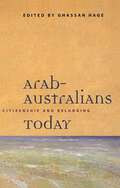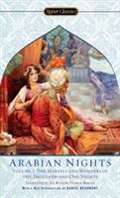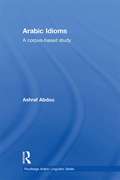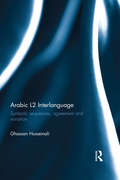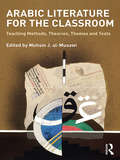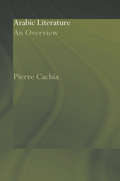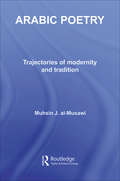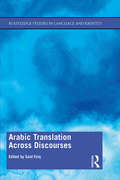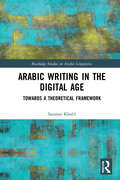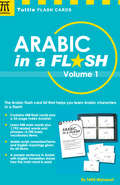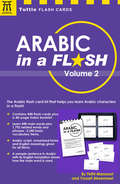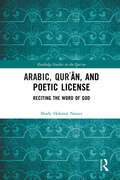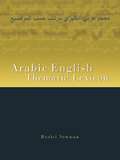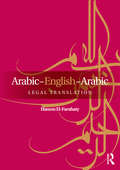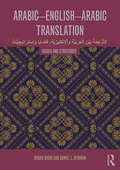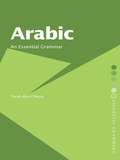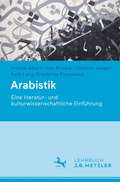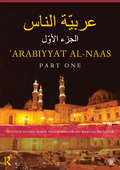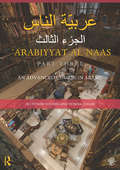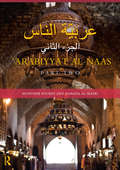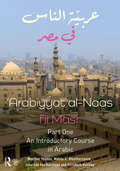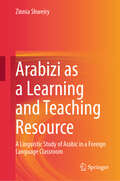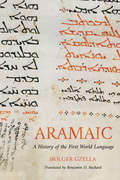- Table View
- List View
Arab-Australians Today: Citizenship and Belonging
by Ghassan HageArab people first came to Australia in the late nineteenth century. Today more than half a million Australians claim some form of Arab ancestry.They are a diverse group, both socially and economically. New South Wales, for example, appointed Australia's first Lebanese Governor, while at the same time it was labelling groups of economically deprived young people as 'Lebanese gangs'. Victoria's Premier, Steve Bracks, comes from a Lebanese background. Melbourne has an important Arab business community, while newly arrived Arab immigrants have one of the highest rates of unemployment in the country.Arab-Australians Today raises important questions about immigration, settlement, marginalisation and participation in Western societies. It discusses the way early Arab immigrants were received in Australia and talks about contemporary issues of participation in the Australian political process. It examines the lives of diverse groups of people, ranging from entrepreneurs to Arab women activists to unemployed youth. It analyses issues ranging from the ways Arab-Australians grow to call Australia home, to the moral panic created around Arab youth and criminality.The book offers non-Arab-Australians a way to better understand the Arab presence in Australia. It is also an invitation for Arab-Australians to reflect on the history of their settlement in Australia, as well as on the current experience of more recent immigrants.
Arabian Nights: The Marvels and Wonders of the Thousand and One Nights
by Sir Richard Francis Burton Jack ZipesAfter King Shahryar had his wife killed for cheating, he began to corrupt--then kill--one virgin a night, as revenge on womankind. Then he meets Scheherazade, who, night after night, saves her own life by telling him fantastical tales of genies, wishes, terror, and passion. Famous stories from here are Aladdin and His Magic Lamp, Ali Baba and the Forty Thieves, and others. Frequent telling of sexual activities through analogy. There is a glossary at the end, which would be helpful to read before beginning. The original (supposedly) 30 volumes were later whittled down to 10 volumes, and now to one volume of the major stories and other of lesser stories.
Arabic Idioms: A Corpus Based Study (Routledge Arabic Linguistics Series)
by Ashraf AbdouIdioms represent a fascinating linguistic phenomenon that has captured the attention of many linguists for decades. This corpus-based study of idioms in Modern Standard Arabic sheds light on their intricate nature, establishes the major patterns of their linguistic behaviour, and provides explanations for these patterns. Adopting a descriptive framework, the study addresses two main issues with regard to the discursive behaviour of idioms: the discursive functions that they perform and the ways in which they contribute to the cohesion of their texts. Examining primary data with regard to the semantic, discursive, lexical and grammatical properties of Arabic idioms, the author touches on the ubiquity of these expressions in language use, the wide range of functions they perform in discourse, the problems they often cause in domains such as foreign language learning and translation, and their typical divergence from the normal rules of grammar and semantic compositionality. Providing explanations for major linguistic phenomena, this analysis will be accessible to linguists, translators, lexicographers, translation software developers, and language teachers as well as learners.
Arabic L2 Interlanguage: Syntactic sequences, agreement and variation (Topics in Arabic Applied Linguistics)
by Ghassan HusseinaliArabic L2 Interlanguage is a significant and timely addition to the field of Second Language Acquisition, providing valuable insight into the development of ‘interlanguage’, the interim language of early beginners, in learners of Arabic. This book: Clearly establishes what interlanguage is and why it should form an important part of foreign language teaching Presents the reader with a sequence in which six English-speaking learners of Arabic acquire the language Makes use of the rich morphological and syntactic property of Arabic to offer a new perspective on the field of Second Language Acquisition. Arabic L2 Interlanguage contributes directly towards building a more comprehensive theoretical framework for explaining how L2s are acquired. It will be key text for SLA scholars as well as an important resource for graduate students in Linguistics and Foreign Language Teaching.
Arabic Literature for the Classroom: Teaching Methods, Theories, Themes and Texts
by Mushin J al-MusawiArabic Literature for the Classroom argues for a more visible presence of Arabic within the humanities and social sciences, stressing the need to make Arabic literature available as a world literature, without damaging its own distinctive characteristics. The nineteen chapters which make up this book broach theoretical and methodical cultural concerns in teaching literatures from non-American cultures, along with issues of cross-cultural communication, cultural competency and translation. While some chapters bring out the fascinating and ever tantalizing connections between Arabic and the literatures of medieval Europe, others employ specific approaches to teaching particular texts, potential methodologies, themes and a variety of topics that can place Arabic widely in a vast swathe of academic application and learning. Topics that are explored include gender, race, class, trauma, exile, dislocation, love, rape, humor, and cinema, as well as issues that relate to writers and poets, women’s writing and the so called nahdah (revival) movement in the 19th Century. The comparative framework and multi-disciplinary approach means that this book injects new life into the field of Arabic Literature. It will therefore be an essential resource for students, scholars and teachers of Arabic Literature, as well as for anyone with an interest in learning more about Arabic culture.
Arabic Literature in the Post-Classical Period
by Roger Allen D. S. RichardsThe final volume of The Cambridge History of Arabic Literature explores the Arabic literary heritage of the little-known period from the twelfth to the beginning of the nineteenth century. Even though it was during this time that the famous Thousand and One Nights was composed, very little has been written on the literature of the period generally. In this volume Roger Allen and Donald Richards bring together some of the most distinguished scholars in the field to rectify the situation. The volume is divided into parts with the traditions of poetry and prose covered separately within both their 'elite' and 'popular' contexts. The last two sections are devoted to drama and the indigenous tradition of literary criticism. As the only work of its kind in English covering the post-classical period, this book promises to be a unique resource for students and scholars of Arabic literature for many years to come.
Arabic Literature to the end of the Umayyad Period
by T. M. Johnstone R. B. Serjeant A. F. L. Beeston G. R. SmithOriginally published in 1983, The Cambridge History of Arabic Literature was the first general survey of the field to have been published in English for over fifty years and the first attempted in such detail in a multi-volume form. The volumes of the History provide an invaluable source of reference and understanding of the intellectual, literary and religious heritage of the Arabic-speaking and Islamic world. This volume begins its coverage with the oral verse of the sixth century AD, and ends with the fall of the Umayyad dynasty two centuries later. Within this period fall major events: the life of the Prophet Muhammad, the founding of the Islamic religion, the great Arab Islamic conquests of territories outside the Arabian Peninsula, and their meeting, as overlords, with the Byzantine and Sasanian world. Contributors to this volume discuss an array of topics including the influences of Greeks, Persians and Syrians on early Arabic literature.
Arabic Literature: An Overview (Culture and Civilization in the Middle East)
by Pierre CachiaAssuming no previous knowledge of the subject, Arabic Literature - An Overview gives a rounded and balanced view of Arab literary creativity. 'High' literature is examined alongside popular folk literature, and the classical and modern periods, usually treated separately, are presented together. Cachia's observations are not subordinated to any pre-formed literary theory, but describe and illustrate the directions taken, in order to present an overall picture of the field of relevance to the student of literature as well as to Arabists working in related fields.
Arabic Poetry: Trajectories of Modernity and Tradition (Routledge Studies in Middle Eastern Literatures)
by Muhsin J. al-MusawiSince the late 1940s, Arabic poetry has spoken for an Arab conscience, as much as it has debated positions and ideologies, nationally and worldwide. This book tackles issues of modernity and tradition in Arabic poetry as manifested in poetic texts and criticism by poets as participants in transformation and change. It studies the poetic in its complexity, relating to issues of selfhood, individuality, community, religion, ideology, nation, class and gender. Al-Musawi also explores in context issues that have been cursorily noticed or neglected, like Shi’i poetics, Sufism, women’s poetry, and expressions of exilic consciousness. Arabic Poetry employs current literary theory and provides comprehensive coverage of modern and post-modern poetry from the 1950s onwards, making it essential reading for those with interests in Arabic culture and literature and Middle East studies.
Arabic Translation Across Discourses (Routledge Studies in Language and Identity)
by Said FaiqA rare contribution to global translation as a ‘cross-cultural-open-concept’, Arabic Translation Across Discourses provides explorations of Arabic translation as an instance of transcultural and translingual encounters (transculguaging). This book examines the application and interrogation of discourses of translation in the translation of discourses (religion, literature, media, politics, technology, community, audiovisual, and automated systems of communication for translation). The contributors provide insights into the concerns and debates of Arabic translation as a tradition with local, yet global dimensions of translation and intercultural studies. This volume will be of great interest to students and researchers of all translation studies, but will also provide a rich source for those studying and researching history, geopolitics, intercultural studies, globalization, and allied disciplines.
Arabic Writing in the Digital Age: Towards a Theoretical Framework (Routledge Studies in Arabic Linguistics)
by Saussan KhalilThe written and spoken forms of Arabic have been traditionally viewed as separate forms of the language that rarely overlap in writing, but this book will examine the recently emerged concept of ‘mixed’ writing that combines both written and spoken forms. This book takes a close look at different examples of mixed Arabic writing in modern (twentieth to twenty-firstt century) print and online literature, offering an analysis of this type of mixing alongside a dynamic model for analysing mixed Arabic writing, and the motivations for producing this type of writing. This book further introduces the ground-breaking concept of the seven writing styles for Arabic, ranging from Classical Arabic to ChatSpeak, whilst also offering an overview of early Arabic literacy and children’s literature. Primarily aimed at Arabic researchers and teachers in linguistics, sociolinguistics, identity studies, politics and Teaching Arabic as a Foreign Language, this book would also be informative for undergraduate and postgraduate students studying Arabic as foreign language, Arabic linguistics and dialectology.
Arabic in a Flash Kit Volume 1
by Fethi MansouriArabic in a Flash: Volume I is an excellent new language learning resource for beginning students of Arabic.This unique set of flash cards enables learners to acquire basic Arabic words and their derivatives in an easy-to-use manner at whatever pace the learner prefers. Each card has Arabic script on one side, with romanized forms and English meanings/derivatives agiven on the other. Contains 448 flash cards plus a 32-page index booklet.Learn 448 main words plus 1,792 related words and phrases--2,700 basic vocabulary items.Arabic script, romanized forms and English meanings given for all items.A sample sentence in Arabic with English translation shows how the main word is used.
Arabic in a Flash Volume 2
by Fethi Mansouri Yousef AlreemawiArabic in a Flash: Volume 2 is an excellent language learning resource for beginning-intermediate students of Arabic.Hot on the success of Volume 1, Arabic in a Flash Volume 2 continues to develop the language skills of the beginning students and others interested in learning Arabic. While Volume 1 has a strong focus on basic communication and vocabulary-building, Volume 2 works to further develop vocabulary and introduces everyday activities, travel and leisure and economic and employment issues.Contains 448 flash cards plus a 48-page index booklet.Learn 448 main words plus 1,792 related words and phrases-2,240 basic vocabulary items.Arabic script, romanized forms and English meanings given for all items.A sample sentence in Arabic with its English translation shows how the main word is used.
Arabic, Qurʾān, and Poetic License: Reciting the Word of God (Routledge Studies in the Qur'an)
by Shady Hekmat NasserThis book examines the similarities between the Qurʾān and ancient Arabic poetry, analyzed through the framework of Arabic grammar prior to their standardization and subsequent development into distinct genres.Of central relevance is the relationship between the Qurʾān and Arabic poetry, and how Muslim scholars defined this relationship based on a formulaic structural approach rather than a thematic and motif-oriented one. The book aims to reposition the so-called non-standard usages of Arabic vernaculars, non-canonical readings of the Qurʾān, and unusual grammatical structures in ancient poetry at the heart of the Arabic-Islamic tradition. The book deals with different theological, legal, and social controversies regarding the proper recitation of the Qurʾān and its individuation from poetry and other verbal arts. For the first time, this study offers a comprehensive categorization of unusual grammatical structures in both the Qurʾān and ancient Arabic poetry, which Arab grammarians classified as poetic license. The close affinity between the linguistic styles of the Qurʾān and ancient Arabic poetry suggests that the Qurʾān was a form of ancient Arabic poetry. To individuate the Qurʾān, Muslim scholars put in place various theological and legal restrictions for its proper recitation, the most important of which was tajwīd (Qurʾānic recitation).The book will interest students and scholars of Qurʾānic and Islamic studies, as well as those researching Arabic poetry and grammar.
Arabic-English Thematic Lexicon
by Daniel L. NewmanThe Arabic-English Thematic Lexicon is an invaluable resource for all learners of Arabic. It contains some 8,000 entries, arranged into themes, including flora and fauna, food and drink, the human body, health care, the family, housing, clothing, education, IT, sports, politics, economics and commerce, the law, media, language, geography, travel, religion, arts, science, and natural resources. Three appendices cover the names of Arab and selected non-Arab regions, countries and capitals, and international organizations. The entries in the Lexicon have been drawn from an extensive corpus of contemporary Standard Arabic vocabulary, based on authentic sources. In addition to verbs, nouns and adjectives, the Lexicon includes phrases and commonly used collocations, providing users with the necessary vocabulary in order to communicate effectively and confidently in both written and spoken standard Arabic. The Lexicon provides an indispensable complement to Arabic grammar instruction and also serves as a useful reference guide for all Arabic language users.
Arabic-English-Arabic Legal Translation
by Hanem El-FarahatyArabic-English-Arabic Legal Translation provides a groundbreaking investigation of the issues found in legal translation between Arabic and English. Drawing on a contrastive-comparative approach, it analyses parallel authentic legal documents in both Arabic and English to examine the features of legal discourse in both languages and uncover the different translation techniques used. In so doing, it addresses the following questions: What are the features of English and Arabic legal texts? What are the similarities and differences of English and Arabic legal texts? What are the difficult areas of legal translation between English and Arabic legal texts? What are the techniques for translating these difficult areas on the lexical and syntactic levels? Features include: A thorough description of the features of legal translation in both English and Arabic, drawing on empirical new research, corpus data analysis and strategic two-way comparisons between source texts and target texts Coverage of a broad range of topics including an outline of the chosen framework for data analysis, a historical survey of legal discourse developments in both Arabic and English and detailed analyses of legal literature at both the lexical and syntactic levels Attention to common areas of difficulty such as Shariah Law terms, archaic terms and model auxiliaries Many examples and excerpts from a wide selection of authentic legal documents, reinforced by practical discussion points, exercises and practice drills to encourage active engagement with the material and opportunities for hands-on learning. Wide-ranging, scholarly and thought-provoking, this will be a valuable resource for advanced undergraduates and postgraduates on Arabic, Translation Studies and Comparative Linguistics courses. It will also be essential reading for translation professionals and researchers working in the field.
Arabic-English-Arabic-English Translation: Issues and Strategies
by Ronak Husni Daniel L. NewmanArabic-English-Arabic-English Translation: Issues and Strategies is an accessible coursebook for students and practitioners of Arabic-English-Arabic translation. Focusing on the key issues and topics affecting the field, it offers informed guidance on the most effective methods to deal with such problems, enabling users to develop deeper insights and enhance their translation skills. Key features include: A focus on Arabic-English translation in both directions, preparing students for the real-life experiences of practitioners in the field In-depth discussion of the core issues of phraseology, language variation and translation, legal translation and translation technology in Arabic and English translation Authentic sample texts in each chapter, taken from a variety of sources from across the Arabic-speaking world to provide snapshots of real-life language use Source texts followed by examples of possible translation strategies, with extensive commentaries, to showcase the best translation practices and methodologies A range of supporting exercises to enable students to practise their newly acquired knowledge and skills Inclusion of a wide range of themes covering both linguistic and genre issues, offering multidimensional perspectives and depth and breadth in learning List of recommended readings and resources for each of the topics under discussion Comprehensive glossary and bibliography at the back of the book. Lucid and practical in its approach, Arabic-English-Arabic-English Translation: Issues and Strategies will be an indispensable resource for intermediate to advanced students of Arabic. It will also be of great interest to professional translators working in Arabic-English-Arabic translation.
Arabic: An Essential Grammar
by Faruk Abu-ChacraArabic: An Essential Grammar is an up-to-date and practical reference guide to the most important aspects of the language. Suitable for beginners, as well as intermediate students, this book offers a strong foundation for learning the fundamental grammar and structure of Arabic. The complexities of the language are set out in short, readable sections, and exercises and examples are provided throughout. The book is ideal for independent learners as well as for classroom study. Features of this book include: coverage of the Arabic script and alphabet a chapter on Arabic handwriting a guide to pronunciation full examples throughout.
Arabistik: Eine literatur- und kulturwissenschaftliche Einführung
by Friederike Pannewick Felix Lang Yvonne Albers Ines Braune Christian JungeDie Umbrüche in der arabischen Welt seit Beginn des Arabischen Frühlings verlangen Veränderungen in der arabistischen Forschung und Lehre. Diese Einführung plädiert für eine Öffnung des Faches für kultur- und sozialwissenschaftliche Fragestellungen und konzentriert sich auf Moderne und Gegenwart (19.–21. Jh.). Der Band stellt die wichtigsten künstlerischen Ausdrucksformen vor: Literatur, Theater, Kunst, Musik und Film. Der Analyse dieser Kunstformen als soziale und kulturelle Praxis ist ein eigenes Kapitel gewidmet. Ein weiterer Teil beschreibt verschiedene Konzepte wie Geschlecht, postkoloniale Identität und Raum. Zudem vermittelt der Band interdisziplinäre Methoden, wie Interviewführung, Feldforschung und betont die Problematisierung der eigenen wissenschaftlichen (Macht-)Position für die Forschungs- und Lehrpraxis einer zeitgemäßen Arabistik.
Arabiyyat al-Naas (Part One): An Introductory Course in Arabic
by Maha Saliba Foster Makda Weatherspoon Munther Younes‘Arabiyyat al-Naas (Part One) offers a groundbreaking introduction to Arabic as it is written and spoken by native speakers. It combines a progressive and rigorous grounding in Modern Standard Arabic (MSA) – the form employed for reading, writing and formal speaking – with an innovative integration of the spoken Levantine variety used in everyday situations in Syria, Lebanon, Jordan and Palestine. Introducing the two simultaneously ‘Arabiyyat al Naas (Part One) uses each in its proper context: Levantine for conversations and MSA for reading and writing activities. In this way, the course efficiently prepares students for the practical realities of learning and "living" Arabic today. Features include: 21 theme-based units covering all the core topics expected in a first-year Arabic course, such as countries, clothes, colors, family and professions a broad range of stimulating activities and exercises fostering active engagement with the course and the development of comprehension and communication skills comprehensively covers the 5 Cs: communication, culture, connections, comparisons and communities a free DVD filmed on location in Jordan, presenting over 40 videos and incorporating a wide variety of entertaining and realistic scenarios a free companion website (www.routledge.com/cw/younes) offering a wealth of additional instructor and student resources, including a teacher’s guide, an introduction to the letters and sounds of Arabic (with audiovisual aid and writing demonstrations), audio recordings of songs and listening passages, video clips, sample tests, an answer key and language games clear explanations of grammatical structures and concepts as they occur in the reading and listening materials to encourage progressive learning and active interaction with the text a user-friendly and vibrant full colour text design, richly illustrated throughout with over 200 illustrations and photographs songs with simple lyrics tied to the themes of the course to help advance vocabulary acquisition and understanding of basic grammatical structures. Written by a dynamic author team and tested over a number of years at Cornell University, ‘Arabiyyat al-Naas (Part One) will be an essential resource for students beginning to learn Arabic. While primarily designed for classroom use, the accessibility of the course and website also renders it highly suitable for independent study. This volume is the first in an exciting three-part series of Arabic textbooks which together provide a complete three-year undergraduate language program.
Arabiyyat al-Naas (Part Three): An Advanced Course in Arabic
by Munther Younes Yomna Chami‘Arabiyyat al-Naas (Part Three): An Advanced Course in Arabic builds further on the groundbreaking approach used in Part One and Part Two of the series. It integrates Modern Standard Arabic (MSA) and spoken Levantine in a way specially tailored to the needs of advanced students. Levantine Arabic strongly features in spoken discussions of MSA materials, reflecting authentic practice by native speakers. However, the overall ratio of MSA – the form employed for reading, writing and formal speaking in the Arab world – to Levantine has been increased, supporting students’ mounting need for MSA as they progress further in their education. This textbook is designed to take learners from the Advanced Low to the Advanced High level according to the ACTFL criteria, and from level B2 to C1 on the CEFR proficiency scales. Features include: 18 theme-based units covering topics such as Arab minorities; education; religion; love and marriage; the Arab woman; economics; politics; military matters; and the environment thorough coverage of listening, speaking, reading, and writing skills with clear grammar explanations and lessons structured to provide opportunities for further practice humorous, realistic dialogues reflecting educated speech among Arabs, to build up strong and practical communication skills attention to issues highly relevant to modern Arab society, encouraging active engagement with the course and further exploration of the themes a rich variety of reading passages from contemporary sources such as Al Jazeera as well as excerpts from the classic works One Thousand and One Nights and Kalila wa Dimna an extensive range of stimulating exercises and activities, including crossword puzzles, root-and-pattern identification exercises, passage completions, and free compositions free companion website (www.routledge.com/cw/younes) with the audio tracks, and texts of the listening passages and answer key. Developed by a dynamic author team and tested over a number of years at Cornell University, ‘Arabiyyat al-Naas (Part Three) is an essential resource for advanced-level students of Arabic. While primarily designed for classroom use, the accessibility of the course also renders it highly suitable for independent study. This volume is the final installment of a pioneering three-part series of Arabic textbooks which together provide a complete three-year undergraduate language program. Munther Younes and Yomna H. Chami both teach Arabic at Cornell University, USA.
Arabiyyat al-Naas (Part Two): An Intermediate Course in Arabic
by Munther Younes Hanada Al-MasriArabiyyat al Naas (Part Two): An Intermediate Course in Arabic offers a vibrant course in Arabic as it is written and spoken today by educated native speakers. Not only does it continue the innovative integration of Modern Standard Arabic (MSA) and Levantine Arabic used in Part One of the series, but it does so in a way that supports and develops students’ increased mastery of the language. Combining a greater focus on cultural topics with an increased coverage of MSA, Part Two introduces more sophisticated communication, giving students a deeper awareness of the cultural base of the Arabic language. Features include: Twenty-one theme-based units covering a wide range of relevant and engaging topics, including education and learning, jobs and professions, the Arab woman, religion, money and the economy, politics and government and the environment Thorough coverage of listening, speaking, writing and reading skills in every unit, with lessons structured to provide students with variety, stimulation and further opportunities for practice Humorous, realistic dialogues reflecting everyday educated speech among Arabs to build up strong and practical communication skills A rich variety of reading passages, including poems, short stories, newspaper articles, descriptions of Arab cities and biographies of famous figures, designed to improve comprehension and analytical skills and to deepen students’ knowledge of Arab history, culture, language, and literature An extensive range of appealing exercises and activities, including crossword puzzles, root-and-pattern identification exercises, passage completions, guided and free compositions, and songs Free accompanying CD that includes audio recordings of the listening materials in the 21 units and a number of songs tied to their themes Free companion website (www.routledge.com/cw/younes) featuring the texts of the listening passages, the audio recordings available on the CD , a track list of all the audio materials, the answer keys to the crossword puzzles, sample tests and language games. Developed by an experienced and dynamic author team and tested over a number of years at Cornell University, Arabiyyat al Naas (Part Two) will be an essential resource for intermediate-level students of Arabic. While primarily designed for classroom use, the accessibility of the course also renders it highly suitable for independent study. This volume is the second in a pioneering three-part series of Arabic textbooks which together provide a complete three-year undergraduate language program.
Arabiyyat al-Naas fii MaSr (Part One): An Introductory Course in Arabic
by Makda Weatherspoon Munther Younes Jonathan Featherstone Elizabeth Huntley‘Arabiyyat al-Naas fii MaSr (Part One) offers a ground-breaking introduction to Arabic as it is written and spoken by native speakers. It combines a progressive and rigorous grounding in Modern Standard Arabic (MSA), the register employed for reading, writing and formal speaking, with an innovative integration of the dominant Egyptian variety. Introducing the two simultaneously and seamlessly building on their shared features, ‘Arabiyyat al-Naas fii MaSr (Part One) uses each in its proper context: Egyptian dialect for conversations and MSA for reading and writing activities. In this way, the course efficiently prepares students for the practical realities of learning and living Arabic today. Features include: Expanded grammar explanations and activation drills, including discussions about colloquial and formal similarities and differences A series of authentic video-clips recorded in Egypt to help learners revise the vocabulary and structures then learn unit by unit Extensive classroom activities and homework exercises that provide constant review to reinforce learning Arabic-English and English-Arabic glossaries, reference charts, and a grammar index Songs with simple lyrics tied to the themes of the course to help advance vocabulary acquisition and understanding of basic grammatical structures A companion website (www.routledge.com/cw/weatherspoon) that features fully integrated interactive, self-correcting exercises, audio and video materials, and additional online course management and grading options for teachers A user-friendly and vibrant text design with full colour, richly illustrated throughout with over two hundred illustrations and photos A teachers manual with an Arabic introduction for the teacher, which lays out the structure of the student course book, its methodology and directions and suggestions for its use. Written by experienced teachers of Arabic and experts in Arabic teaching pedagogy, ‘Arabiyyat al-Naas fii MaSr (Part One) is an essential resource for students beginning to learn Arabic.
Arabizi as a Learning and Teaching Resource: A Linguistic Study of Arabic in a Foreign Language Classroom
by Zinnia ShweiryThis book is the first of its genre to explore the use of Arabizi, the Romanized script of the Arabic language that is used online or in chat apps, in the Arabic as a Foreign Language (AFL) classroom. It fills a noticeable, and glaring, gap in teaching a non-Romanized language through Romanized representation by observing and studying Arabizi as a resource that is yet to be acknowledged. As such, the author aptly, and concurrently, addresses concerns and problems that arise in AFL learning. An essential resource for studies in language acquisition, the author carves a new niche in the study of phonology, and phonetics, particularly so in L1 and L2 studies, with succinct and up-to-date examples. Relevant to applied linguistics and language educators in Arabic, it also draws comparisons between Chinese and Arabic alphabets in analyzing L1 and L2 purposes, making it a unique linguistic comparative contribution to the study of languages in classroom settings.
Aramaic: A History of the First World Language (Handbook Of Oriental Studies. Section 1 The Near And Middle East Ser. #111)
by Holger GzellaIn this volume—the first complete history of Aramaic from its origins to the present day—Holger Gzella provides an accessible overview of the language perhaps most well known for being spoken by Jesus of Nazareth. Gzella, one of the world&’s foremost Aramaicists, begins with the earliest evidence of Aramaic in inscriptions from the beginning of the first millennium BCE, then traces its emergence as the first world language when it became the administrative tongue of the great ancient Near Eastern empires. He also pays due diligence to the sacred role of Aramaic within Judaism, its place in the Islamic world, and its contact with other regional languages, before concluding with a glimpse into modern uses of Aramaic. Although Aramaic never had a unified political or cultural context in which to gain traction, it nevertheless flourished in the Middle East for an extensive period, allowing for widespread cultural exchange between diverse groups of people. In tracing the historical thread of the Aramaic language, readers can also gain a stronger understanding of the rise and fall of civilizations, religions, and cultures in that region over the course of three millennia. Aramaic: A History of the First World Language is visually supplemented by maps, charts, and other images for an immersive reading experience, providing scholars and casual readers alike with an engaging overview of one of the most consequential world languages in history.
